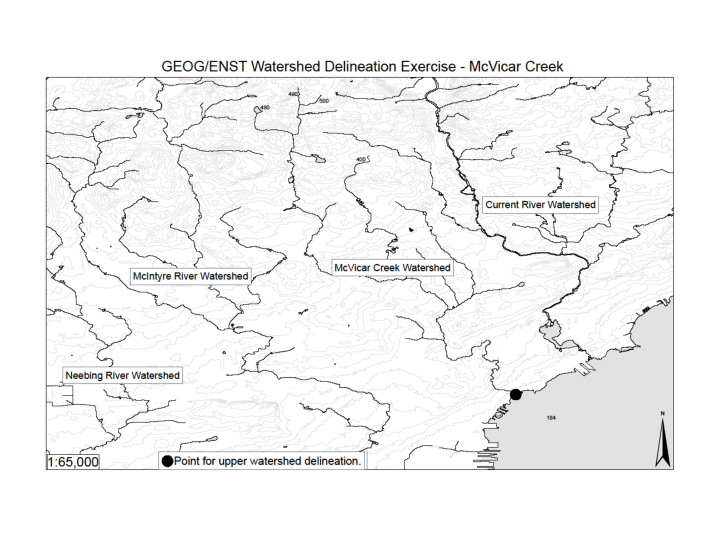



Graham Saunders Weather Works
Outline Weather conditions of evening of May 27 Summary of heavy rain event – May 28 Antecedent moisture conditions and overland flow 50 -100-year events (IDF curves) Rainfall measurement: potential errors Historical Storms CIMA Report Discussion Slide 3
Weather conditions late evening on May 27 A low-pressure system and associated warm front moved from western Minnesota to southwest of Thunder Bay. Environment Canada Forecast at 4 PM SUNDAY 27 MAY 2012 TONIGHT..SHOWERS WITH RISK OF A THUNDERSTORM. AMOUNT 10 TO 15 MM . . . Slide 4
Defining Rain Events Light rain: to 2.5 mm per hour Moderate rain: 2.6 mm to 7.5 mm per hour Heavy rain: more than 7 mm per hour > 50 mm in 24 hours = a heavy rain day Slide 7
Some Rain Statistics for Thunder Bay – May 28, 2012 Rain began in Thunder Bay on May 28 at midnight • 50 mm was recorded between 00:15 - 01:15 a.m. (1-hour record) • 70 mm in two hours (2-hour record) • 100 mm in 24-hour • 65 mm: average precipitation for the month of May • May rain total: 201 mm (monthly record for May) Slide 8
Colour Precipitation Intensity Weather Description Blue Light Rain or snow Cyan Moderate Rain or snow Light thunderstorms and/or Green Heavy moderate rain showers Yellow Very Heavy Moderate thunderstorms Red Intense Potential flooding rains and severe thunderstorms Magenta Flooding rains with severe Extreme thunderstorms / Purple
Making Sense of Radar Charts Rainfall intensity Radar displays spot estimates of rain amounts per hour Example: Red has a range of 75 to 100 mm/hr • Isolated thunderstorms • Lines of thunderstorms Typically, these pass over a location moderately quickly In the following we see this feature, also thunderstorms that are stationary or re-form Slide 10
Environment Canada Warning: Severe Thunderstorms SEVERE THUNDERSTORM WARNING, ISSUED BY ENVIRONMENT CANADA AT 1:27 AM EDT MONDAY 28 MAY 2012. --------------------------------------------------------------------- SEVERE THUNDERSTORM WARNING FOR: =NEW= CITY OF THUNDER BAY =NEW= ATIKOKAN - SHEBANDOWAN - QUETICO PARK =NEW= SUPERIOR WEST. --------------------------------------------------------------------- ==DISCUSSION== A LINE OF NEARLY STATIONARY THUNDERSTORMS STRETCHES ALONG HIGHWAY 11 TO THE WEST TO THUNDER BAY INTO THE CITY OF THUNDER BAY ITSELF. LOCAL RAINFALL AMOUNTS OVER 50 MM ARE EXPECTED BEFORE THE HEAVIEST RAIN TAPERS OFF IN THE NEXT HOUR OR TWO. HOWEVER, MORE RAIN IS STILL EXPECTED DURING THE NIGHT AND MONDAY . …
May 1 to 22: featured average rainfall May 24: Heavy rain day (50 to 60 mm measured) May 25 to 27: 5 to 25 mm Overland (surface) water flow
Thunder Bay Airport Intensity Duration Frequency Rain intensity exceeds 100-year return Slide 19
Rainfall Measurements Problems and potential errors especially with heavy rain events equal to or greater than 75 millimetres. Rain gauge location Wind Mechanical errors Rain totals tend to under report actual amounts.
Thunder Bay Historical Storms Date 24 Hour Average Antecedent Feb. 2, 2007 Wild-weather future Total Rate Intergovernmental Panel on Climate Change, (mm) (mm/hour) (mm) 4th Assessment: “Earth is nearing the stage . . . Sept. 10, 1961 98.0 4.4 12.0 May 24, 1971 76.2 3.2 54.1 irreversible change to the planet”. Sept. 26, 1973 87.1 5.8 4.9 Sept. 8, 1977 131.2 5.5 3.7 June 28, 1996 87.7 8.0 2.0 July 2, 1997 80.4 4.0 25.6 June 6, 2008 78.8 6.1 8.0 May 28, 2012 91.3 20.3 66.4 Average hourly rate: Total divided by storm duration (see page 22)
Atlantic Avenue WPCP Flooding Assessment December 3, 2012
Source of Flooding Flooding Started Here 23
Source of Flooding • Flooding started in Preliminary Treatment Building and progressed to all other tunnels around the plant including ultimately pump station dry well • Suggests excessive plugging and headloss across influent screens • Direction of door buckling confirms flooding from main level in Headworks down into tunnel 24
Estimated Plant Flows • All flow to plant is through an on-site pumping station • Design capacity 766 ML/d • Equipped with 5 pumps (4 duty) • Plant flow meter is calibrated to a maximum of 668 ML/d • Applied first principles engineering approach using wet well level and manufacturer pump data to estimate flow from station 25
Normal Dry Weather Plant Flow Typical Day Flow (70-80 ML/d) Typical Night Flow (50-60 ML/d) 26
Plant Flow During Flooding (May 28, 2012) 27
May 28 th Plant Flow • Estimated flow to the plant exceeded 1000 ML/d (more than 30% greater than station firm capacity) • Average pump station output from 2 am to 3:30 am (before drywell flooding) approximately 800 ML/d • Greater than station design capacity • Unable to maintain normal pump station operating level due to incoming flow exceeding station capacity 28
Recommend
More recommend